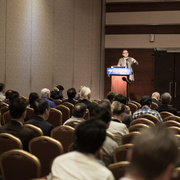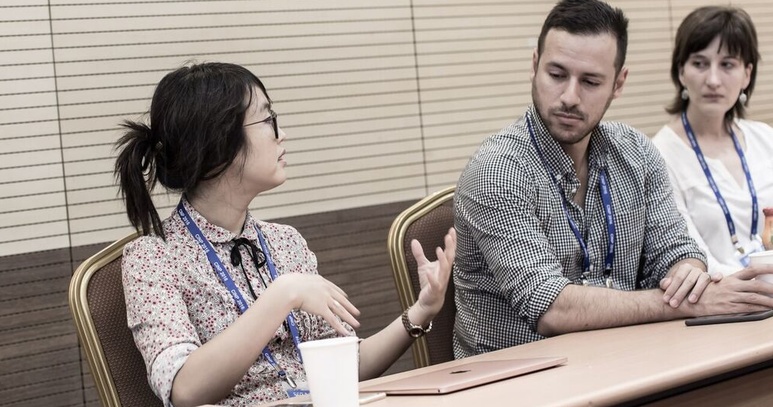
Choose a channel
Check out the different Progress in Mind content channels.

Progress in Mind

Professor Xiao-Jing Wang, New York University & NYU Shanghai, USA & China, shared developments in the computational modeling of GABA microcircuitry and cognitive deficits in schizophrenia.
Professor Wang seeks to understand the dynamic behaviour and function of neural circuits. He investigates neural mechanisms and computational principles of cognitive processes - such as decision making and working memory - using theoretical and modeling approaches. Neural network modeling is a valuable tool to bridge the gaps between levels of investigation that would be difficult to achieve experimentally. Accurate microcircuit models may direct our approach to treating mental disorders, including schizophrenia.
Neural network modeling allows us to bridge the gaps between levels of investigation that would be difficult to achieve experimentally.
Mental disorders mainly involve cognitive-type brain systems, such as the prefrontal cortex (PFC) - often called "the CEO of the brain". Professor Wang has investigated the microcircuit properties that enable a cortical area, such as the PFC, to carry out cognitive functions. Wang proposed that the cognitive function of cortical areas is due to an interplay between slow reverberating excitation and competitive synaptic inhibition.
Working memory is a key cognitive function that is impaired in mental disorders. Using computational circuit modeling of the PFC, Professor Wang has shown that working memory deficits in schizophrenia arise from an inability to filter out distractors that are behaviourally irrelevant - rather than problems with working memory storage. This interesting finding was confirmed by human study.
The prefrontal cortex is often called "the CEO of the brain".
Resistance against distractors in a working memory circuit depends on several subtypes of interneurons, soma-, dendrite-, and interneuron-targeting interneurons, which are all modulated differently by dopamine.
Professor Wang suggested a novel perspective on GABA signaling impairment in mental disorders. The GABA system consists of several inhibitory cell types. Different types of interneurons can set up a gating mechanism that is used by the brain to flexibly route information flow to the right place at the right time - based on behavioural demands. Diverse GABAergic cell types are found throughout the brain. Their functions need to be fully investigated - both experimentally and theoretically - using large-scale, cross-level, brain circuit modeling.
A novel perspective on GABA signaling impairment in mental disorders.
Professor Thomas Klausberger, Medical University Vienna, Austria, discussed the contribution of distinct types of GABAergic interneurons to working memory and decision making.
The cerebral cortex is made up of highly diverse neuronal types, including excitatory pyramidal cells, and GABAergic inhibitory interneurons - which control the activity and timing of pyramidal cells. Professor Klausberger is investigating how distinct types of neurons support the executive functions of the PFC.
Freely-moving rats performed a delayed cue-matching-to-place task, which involves working memory and decision making. The rats were given a stimulus - either chocolate or cherry - and after a six second delay they ran either down the left path (chocolate) or the right path (cherry). A reward was at the end of the road for those rats that made the right choice - based on the initial stimulus.
During this task, GABAergic interneurons and pyramidal cells in the PFC were recorded using the juxtacellular recording and labelling technique - and their contribution to network oscillations investigated.
Two groups of pyramidal neurons showed task-related firing patterns - neurons that represented the future goal and those that fired during distinct periods of the task. Distinct types of interneurons modulated these firing patterns.
Distinct types of GABAergic interneurons contribute to working memory and decision making.
By recording identified neurons, Professor Klausberger has shown how distinct types of neurons contribute to prefrontal network operations and executive behaviour. These results indicate that GABAergic interneurons release GABA at distinct times to different domains of pyramidal cells - like percussions in music.
GABAergic interneurons release GABA at distinct times - like percussions in music.
Professor John Krystal, Yale University, USA, and CINP President Elect, spoke about GABA-related dysfunctional cortical activity in schizophrenia.
Molecular and cellular changes have been observed in post-mortem tissue from patients who had schizophrenia. But we don’t yet know how these alterations cause schizophrenia’s characteristic symptoms and cognitive impairment.
Professor Krystal and colleagues analyzed healthy subjects and patients with schizophrenia using functional MRI (fMRI) and electroencephalography (EEG). They also looked at healthy subjects given the N-methyl-D-aspartate receptor (NMDA-R) antagonist, ketamine - which causes similar symptoms to and is a pharmacological model of schizophrenia. The results were interpreted alongside relevant computational neuroscience models of the behaviour of cortical micro- and macro-circuits.
Professor Krystal described different types of network disinhibition seen in these studies.
One of those is pathological hyperconnectivity - a feature of early course (high-risk, first episode) schizophrenia that is associated with symptoms of psychosis. Long-term hyperconnectivity produces volume loss in schizophrenia. In first episode schizophrenia, hippocampal hypermetabolic regions predict volume loss in chronic psychosis.
The signal properties of cortical functional connectivity change as schizophrenia progresses. This finding opens the door for phase-specific pharmacotherapy - treating schizophrenia differently at different stages of the illness.
Schizophrenia has a dynamic neurobiology that changes over the course of the illness.
Schizophrenia is associated with heterogeneous pathophysiologies - a finding which has not been adequately addressed by treatment efforts.
Professor Krystal drew attention to the time-dependent neurobiological evolution of schizophrenia. Based on the idea that schizophrenia has a dynamic neurobiology that changes over the course of the illness, he proposed phase-specific pharmacotherapy. The disinhibitory phase - early course of the illness - can be targeted with treatments that restore inhibition. But in the atrophic, chronic phase, inhibitory treatments may worsen deficits in synaptic connectivity.
The developmental neurobiology of schizophrenia needs to be characterized further - to enable us to treat patients better. Such studies should use our knowledge of the genetics and epigenetics of schizophrenia.
It is hoped that neurodevelopmental and homeostatic processes may allow us to identify time-dependent sources of cortical network dysfunction that correspond with the clinical phases of schizophrenia.
Professor Etienne Sibille, Centre for Addiction and Mental Health, Canada, changed the direction of the symposium as he presented findings on GABA-related cellular and molecular pathology in depression.
Somatostatin (SST) is a selective marker for GABA neurons that regulates pyramidal cell dendrites. SST is reduced in major depressive disorder (MDD). In fact, low SST is also reported in schizophrenia, bipolar disorder, Alzheimer’s disease, epilepsy and other conditions. SST may be a vulnerable biological module in the brain.
The important questions are, does low SST contribute to psychiatric symptoms, particularly mood disorders? And does targeting low SST have antidepressant potential?
Exploring new drug targets in depression.
Professor Sibille described human postmortem molecular studies and animal genetic and pharmacological studies as he addressed these questions.
Genetic studies in mice suggested that low SST and reduced SST-positive GABA neurons have a role in causing mood symptoms, and may be targets for novel antidepressants.
The function of SST-positive GABA neurons is mediated by post-synaptic GABA-A receptors that contain the alpha5 subunit. These receptors are found mostly in the hippocampus and cortex. Boosting alpha5-mediated GABA function (through positive allosteric modulation) has antidepressant activity in mice.
Professor Sibille also described another potential new drug target - based on the idea that altered eukaryotic initiation factor 2 (EIF2) signaling may be linked to dysregulation of SST expression and high emotionality. He and colleagues have shown that activating EIF2 signaling through EIF2 kinase inhibition diminished stress-induced behavioural emotionality in mice.
CINP symposia bring together the latest advances in basic, clinical and translational neuropsychopharmacology relevant to mental illness and treatment.











In a world of seemingly endless ways and means to keep abreast of the latest research, and countless virtual channels through which to forge networks and relationships, it seems the traditional congress is still very much alive.
At a closed workshop held during CINP 2016, a number of the recipients of the Young Investigator travel award* were brimming with ideas about ways to enhance the congress experience, yet were unanimous that the tried-and-tested elements of the congress concept still hold great appeal for young scientists and clinicians.
Attending talks by experts, networking with peers, hearing the latest research-thinking and taking time out from the rigors of their everyday research work and clinical practice – to reflect on the broader aspects of neuroscience and psychiatry – are enriching experiences. According to the young investigators at CINP, there is no substitute for face-to-face meetings and being part of the community engendered by a congress.
But that’s not to say that meeting and congress organizers should be complacent, or that there aren’t opportunities to make the congress experience better.
The Millennial app- and twitter-savvy generation want congress plans at their finger-tips, and sharing on social media is a given. Young investigators appreciate that congress data may be new and embargoed information, yet can see that high quality facts, opinions and concepts are worthy of wider dissemination. During the workshop, young investigators used the example of TEDx talks – ‘ideas worth spreading’ – which keep conversations going long after an event as an approach congresses could adopt, and during the congress, they would be more than happy to use and share handles and hashtags to communicate congress ideas and messages. They just want presenters to realise that when a delegate appears to be on their ‘phone – it probably means they are tweeting pearls of wisdom from the talk!
Young investigators appreciate that short of a major culture change, their older peers may not all rush to embrace twitter, but they suggested that facebook and facebook pages have broader generational appeal and they think that medical societies could work, for example, with student helpers willing to be their social media whizzes (officers) who establish and run social media campaigns.
During a congress, young investigators find plenary lectures by thought leaders and poster sessions to be excellent learning and idea-generating experiences. Soaking up ideas and being able to meet and talk with other scientists and clinicians is something the CINP young investigators think should be a regular event in their calendars. While not averse to e-learning opportunities and catching up on missed congress events via post-congress webcasts, the up-coming generation would prefer a concentrated dose of real-time interaction with their colleagues.
* Jee Hyun Kim, Australia; Jiamei Lian, Australia; Daniel Quintana, Australia; Saddichha Sahoo, Australia; Giulia Treccani, Italy (currently working in Denmark)
Young investigators, attending CINP 2016 through the Rafaelsen travel award scheme, shared their thoughts on what they like about coming to meetings.